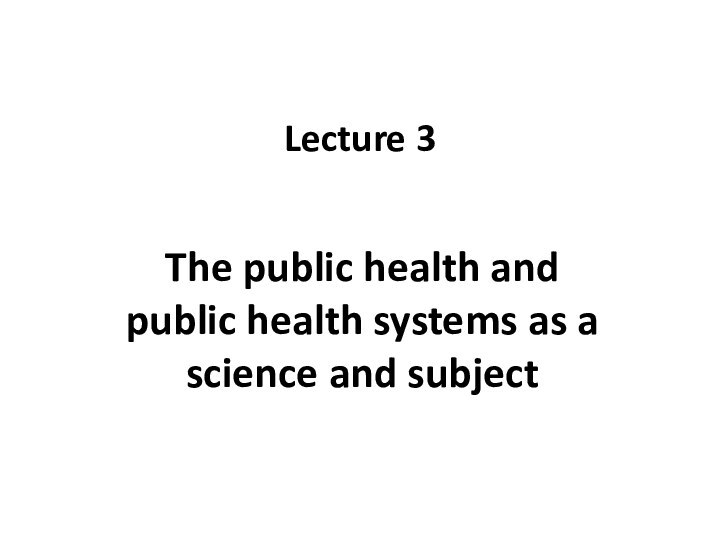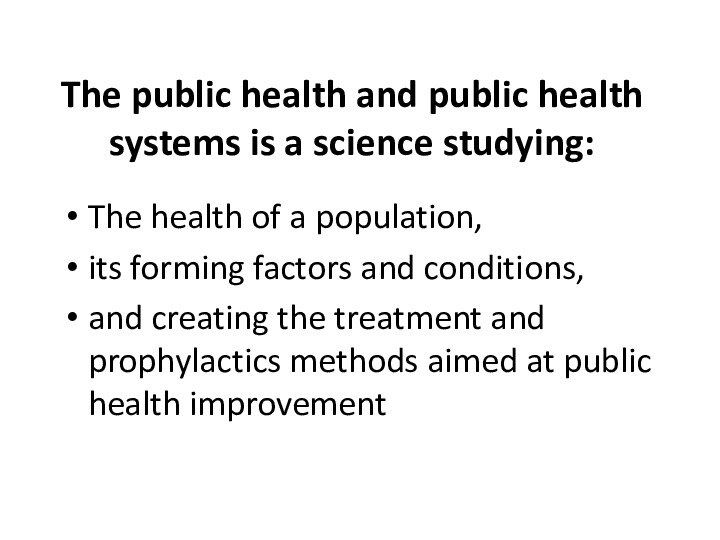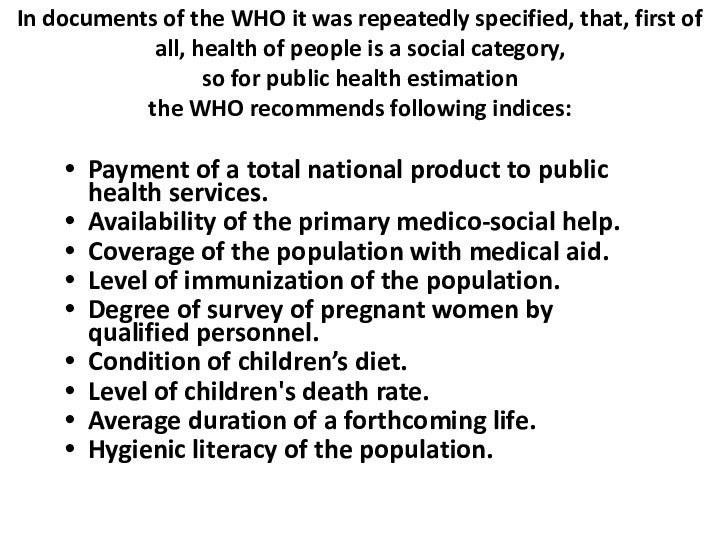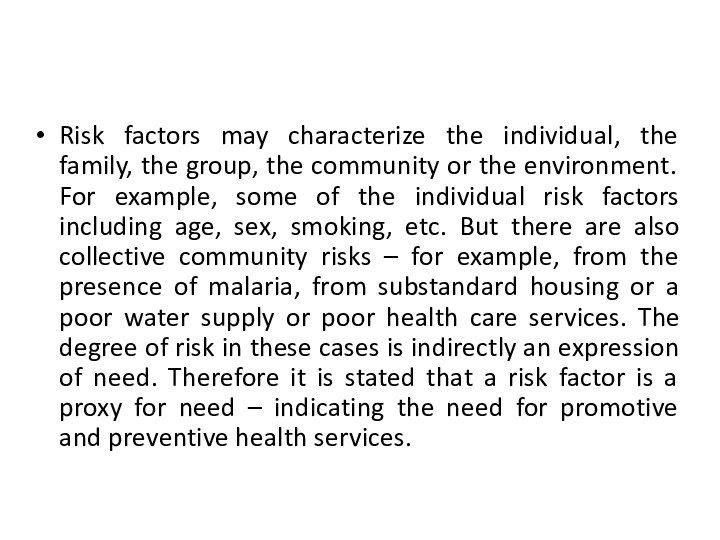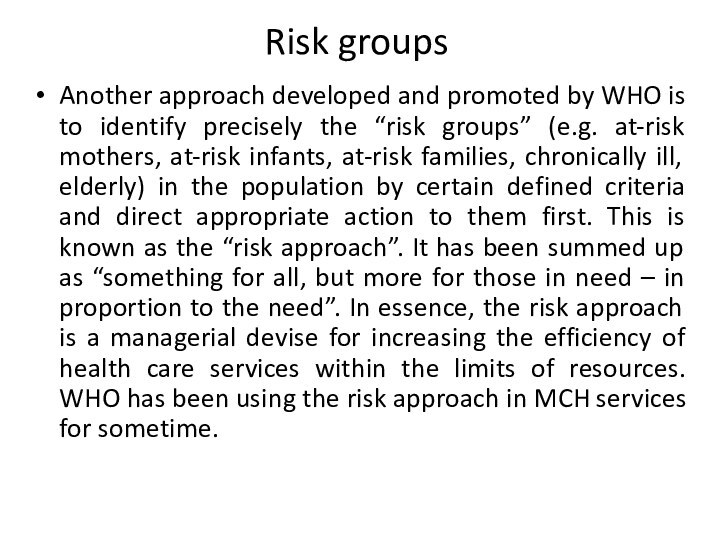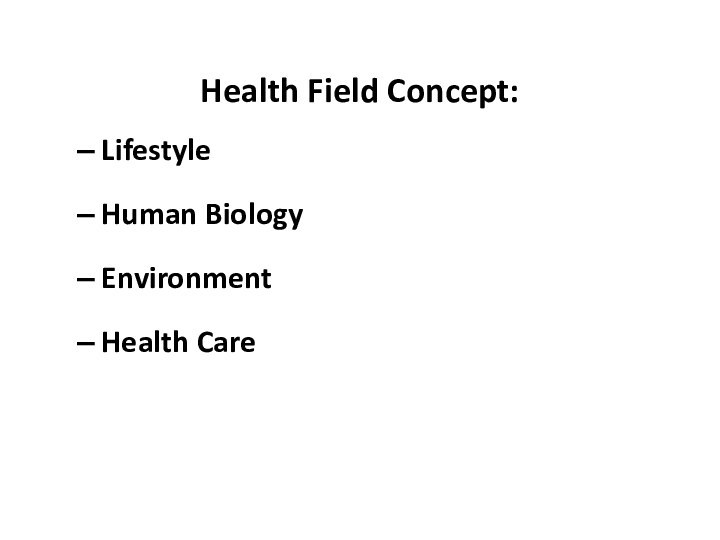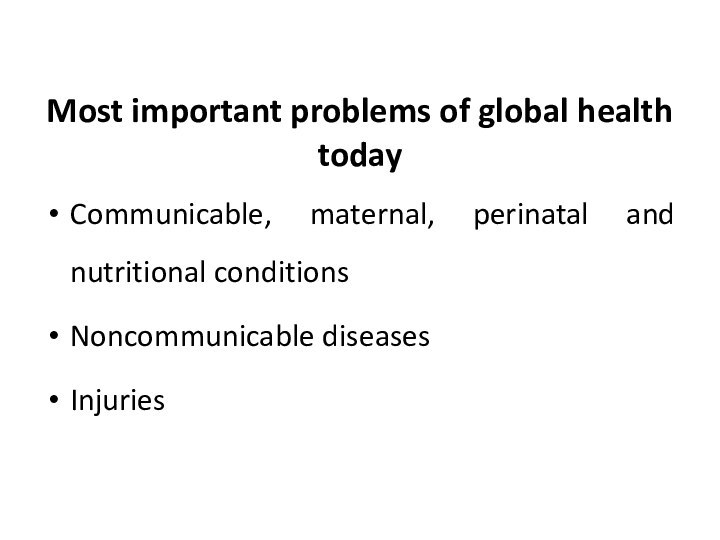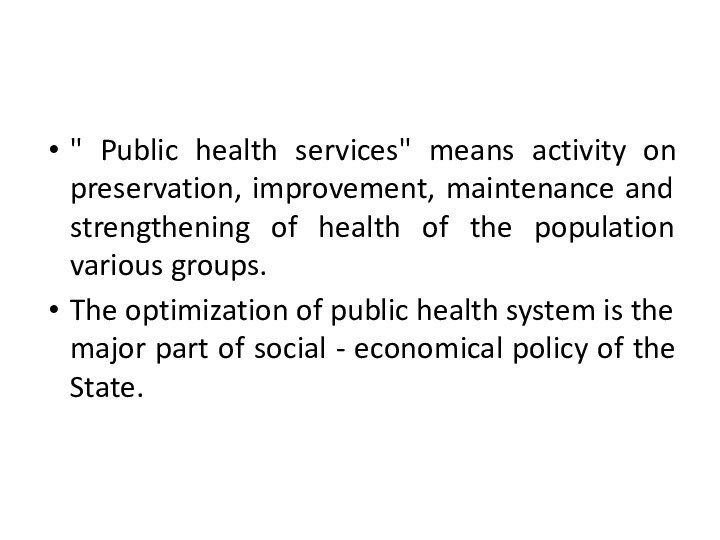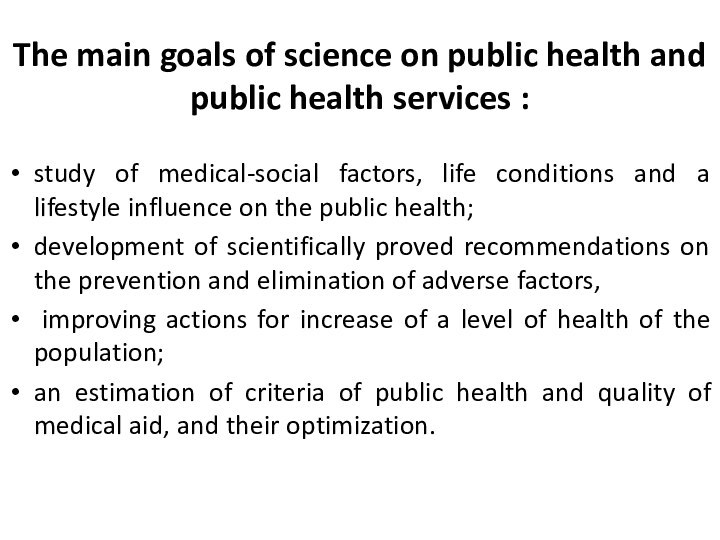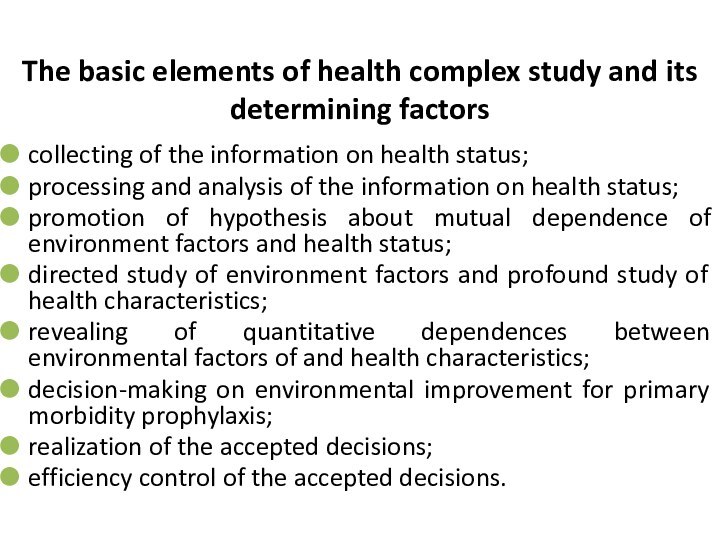Слайд 2
The public health and public health systems is
a science studying:
The health of a population,
its forming
factors and conditions,
and creating the treatment and prophylactics methods aimed at public health improvement
Слайд 3
Many Ukrainian and Russian doctors also considered, that
"it is necessary to treat not illness, but a
patient", that is a person taking into account individual character, temperament, life and work conditions. At the end of the 18th century many of the professors of the Moscow University stressed the necessity of public health study and introduction of a new subject at medical faculties. But the lecture course on public health has been introduced only in the second half of the 19th century, and only at several medical faculties and occasionally.
Слайд 4
А definition of "health"
In the
modern literature there is a considerable quantity of definitions
of "health," however the basic one, adopted in all countries, is a definition of the World Health Organization (WHO). In the WHO Charter accepted in 1948 it is written: "Health is a condition of full physical, spiritual and social well-being, and not just absence of illnesses and physical defects."
Слайд 5
In medico social researches, at health estimation, it
is accepted to point out four levels:
1. Health
of a separate person – individual health;
2. Health of social and ethnic groups – group health;
3. Health of the population of administrative territory – regional health;
4. Health of population, a society as a whole – public health.
Unlike the majority of medical and clinical disciplines dealing with a separate person, an individual and his health, public health and public health systems studies a state of health of all population of the country.
Слайд 6
For a quantitative estimation of group, regional and
public health it is customary to use the following
indices:
1. Demographic indices (death rate, birth rate, average life expectancy).
2. Morbidity rate.
3. Disability rate.
4. Indicators of physical development of the population.
The greater part of these indicators is of negative character; it concentrates doctors’ attention to pathological conditions and health definition through morbidity intensity.
Слайд 7
However, in the majority of countries of the
world the main function of public health services system
at present is prevention of diseases and health preservation of healthy people; that is why it is very important to use the indicators positively estimating health. They are:
1. A health index – a share of practically healthy population, which did not appeal for medical aid on account of diseases within a year;
2. Average duration of healthy life and others.
Слайд 8
In public health study the following classification of
factors that define it is applied:
Social and economic
factors (material well-being, living conditions, working conditions, food quality, mutual relations in a family and others);
Biological factors (sex, age, heredity, temperament etc.);
Ecological, natural and climatic factors (climate, weather, air condition, water, soil, level of solar radiation, etc.);
Medical and organizational factors (availability and quality of a medical and social help).
Conditions of a personal and collective life can be united and form a concept – a way of life.
Слайд 9
Features of Ukrainians’ life-style
Regularly go in for physical
training - 12 % of Ukrainians
Consume alcohol–21 %
Smokers -
45 % of the population
Formation of a healthy way of life in these conditions is the basic means of primary preventive maintenance and should become the basic purpose of social policy and major duty of all medical workers.
Слайд 10
In documents of the WHO it was repeatedly
specified, that, first of all, health of people is
a social category,
so for public health estimation
the WHO recommends following indices:
Payment of a total national product to public health services.
Availability of the primary medico-social help.
Coverage of the population with medical aid.
Level of immunization of the population.
Degree of survey of pregnant women by qualified personnel.
Condition of children’s diet.
Level of children's death rate.
Average duration of a forthcoming life.
Hygienic literacy of the population.
Слайд 11
Risk factors may be truly causative (e.g., smoking
for lung cancer); they may be merely contributory to
the undesired outcome (e.g., lack of physical exercise is a risk factor for coronary heart disease), or they may be predictive only in a statistical sense (e.g., illiteracy for perinatal mortality).
Слайд 12
Risk factors may characterize the individual, the family,
the group, the community or the environment. For example,
some of the individual risk factors including age, sex, smoking, etc. But there are also collective community risks – for example, from the presence of malaria, from substandard housing or a poor water supply or poor health care services. The degree of risk in these cases is indirectly an expression of need. Therefore it is stated that a risk factor is a proxy for need – indicating the need for promotive and preventive health services.
Слайд 13
Risk groups
Another approach developed and promoted by WHO
is to identify precisely the “risk groups” (e.g. at-risk
mothers, at-risk infants, at-risk families, chronically ill, elderly) in the population by certain defined criteria and direct appropriate action to them first. This is known as the “risk approach”. It has been summed up as “something for all, but more for those in need – in proportion to the need”. In essence, the risk approach is a managerial devise for increasing the efficiency of health care services within the limits of resources. WHO has been using the risk approach in MCH services for sometime.
Слайд 14
Conclusion:
Modern epidemiology is concerned with the identification of
risk factors and high-risk groups in the population. Since
resources are scarce, identification of those at risk is imperative. It helps to define priorities and points to those most in need of attention.
The knowledge of risk factors and risk groups can be used to prevent disease in so far as we are able to remove or minimize the risk.
Слайд 15
Theories of health:
the theory that health is an
ideal state,
the theory that a person is healthy
if she can function in a socially useful role,
the theory that health can be bought or given as if it is a commodity,
the theory that health is an ability or strength to adapt to the changing challenges and circumstances of life, etc.
Слайд 16
Three Broad Concepts of Health
Medical (Traditional)
Behavioural
(Lifestyle)
Socio-Environmental (Structural)
These approaches lead to different definitions of problems, different strategies, different target groups, and different people responsible for the activities of promoting health.
Слайд 17
Health Field Concept:
Lifestyle
Human Biology
Environment
Health Care
Слайд 18
Most important problems of global health today
Communicable, maternal,
perinatal and nutritional conditions
Noncommunicable diseases
Injuries
Слайд 19
" Public health services" means activity on preservation,
improvement, maintenance and strengthening of health of the population
various groups.
The optimization of public health system is the major part of social - economical policy of the State.
Слайд 20
Public health professionals try to prevent problems from
happening or re-occurring through implementing educational programs, developing policies,
administering services, regulating health systems and some health professions, and conducting research.
Science of public health is also a field that is concerned with limiting health disparities and a large part of public health is the fight for health care equity, quality, and accessibility.
Слайд 21
Public health is mainly composed of the following
core areas:
Behavioral Science/Health Education
Biostatistics
Emergency Medical Services
Environmental Health
Epidemiology
Health Services
Administration/Management
International/Global Health
Maternal and Child Health
Nutrition
Public Health Laboratory Practice
Public Health Policy
Public Health Practice
Слайд 22
Maternal and Child Health
Providing information and access to
birth control; promoting the health of a pregnant woman
and an unborn child; and dispensing vaccinations to children are part of maternal and child health.
Professionals in maternal and child health improve the public health delivery systems specifically for women, children, and their families through advocacy, education, and research.
Слайд 23
The main goals of science on public health
and public health services :
study of medical-social factors, life
conditions and a lifestyle influence on the public health;
development of scientifically proved recommendations on the prevention and elimination of adverse factors,
improving actions for increase of a level of health of the population;
an estimation of criteria of public health and quality of medical aid, and their optimization.
Слайд 24
Four categories of the general indices which characterize
a condition of public health services in any country
according to the World Health Organization (WHO):
the governmental policy in the field of public health service;
social and economic indices;
indices of security of the medical-social help;
Indices of health status of the population.
Слайд 25
Structure of a subject “Public health and health
care service”:
a history of public health services;
theoretical
problems of public health services;
the state of health and methods of its studying;
the organization of medical-social security and medical insurance
the organization of medical aid to the population;
maintenance of sanitary-and-epidemiologic well-being of the population;
Economic forms of perfection of public health services, management, marketing and modelling of medical services;
the international cooperation in the field of medicine and public health services.
Слайд 26
Methods of medical-social researches:
historical;
dynamic observation and
the description;
sanitary – statistical method – as a basic;
the medical-sociological analysis;
expert estimations; expertise assessment method
the system analysis and modelling;
organizational experiment;
scheduled - normative, etc.
Слайд 27
Objects of medical -social
researches are:
groups of
persons, the population of administrative territory;
separate establishments (polyclinics,
hospitals, the diagnostic centres, the specialized services);
public bodies and establishments of public health services;
objects of an environment;
the general and specific risk factors of various diseases, etc.
